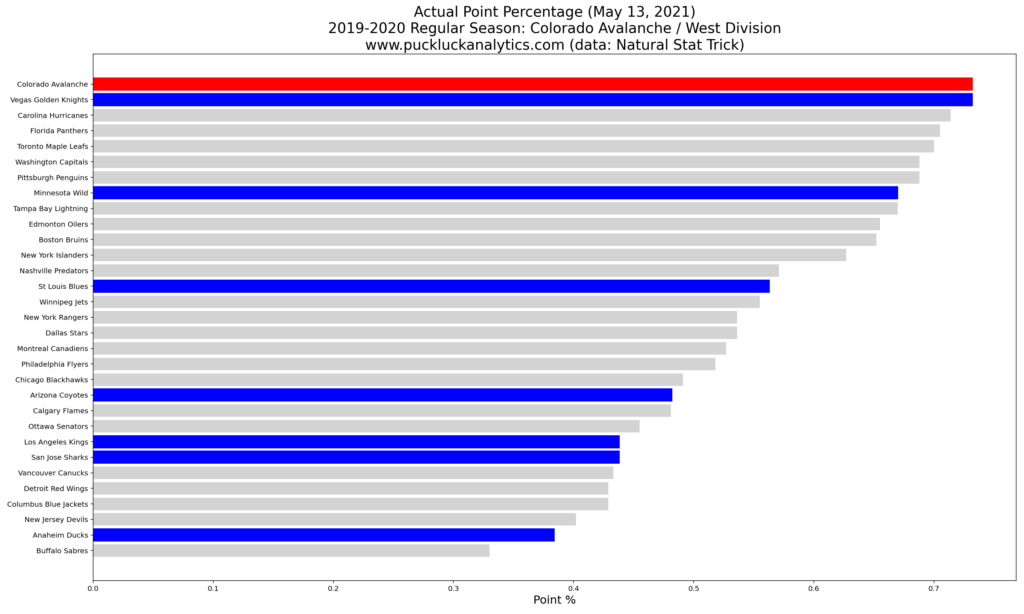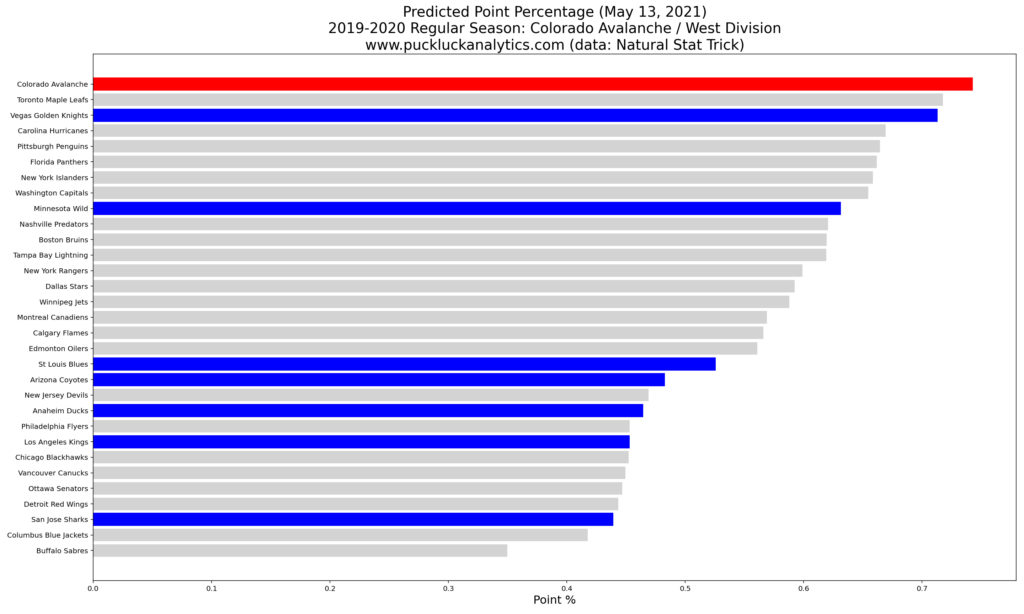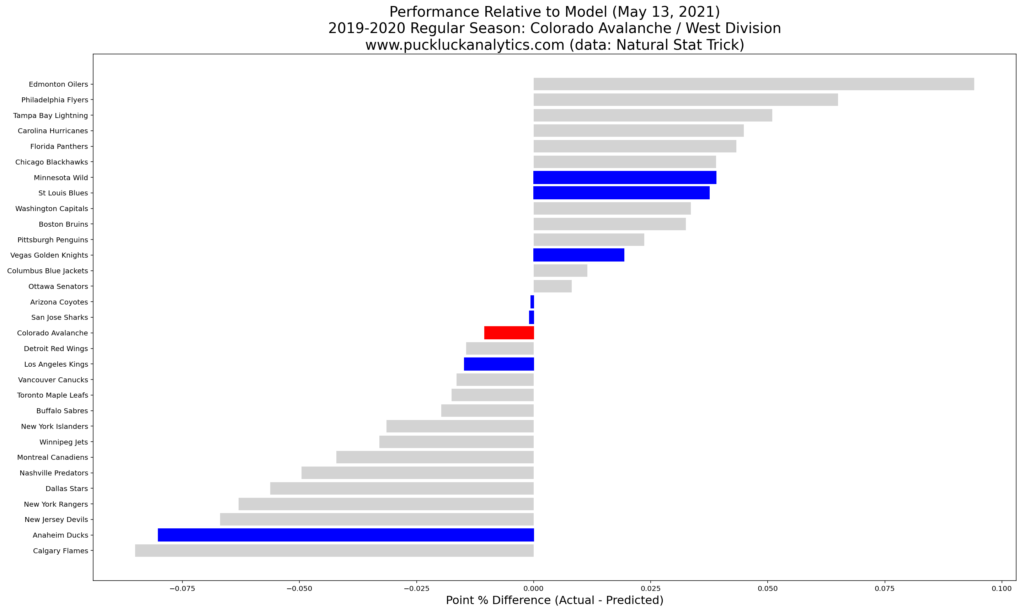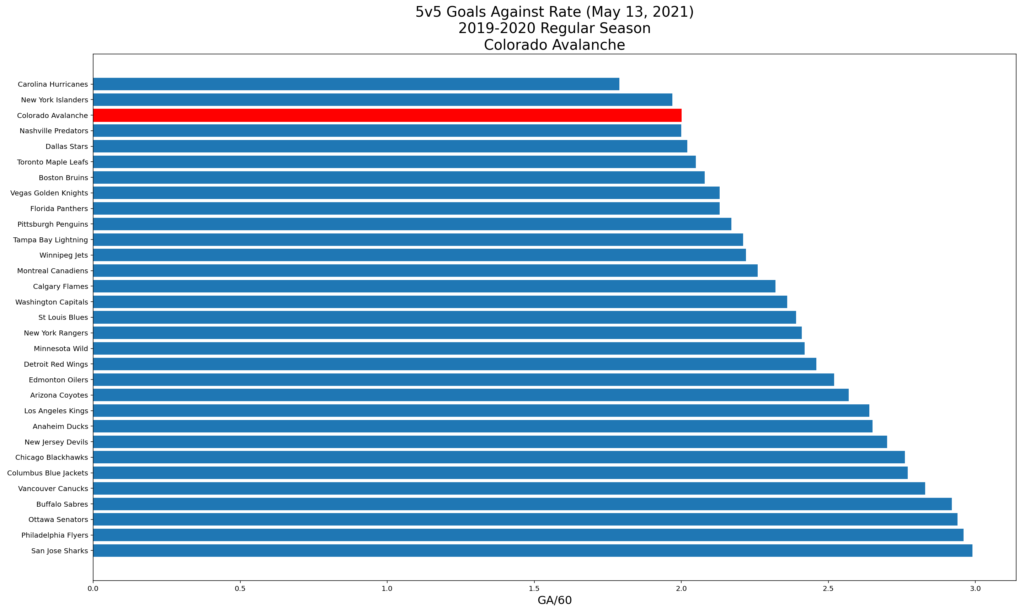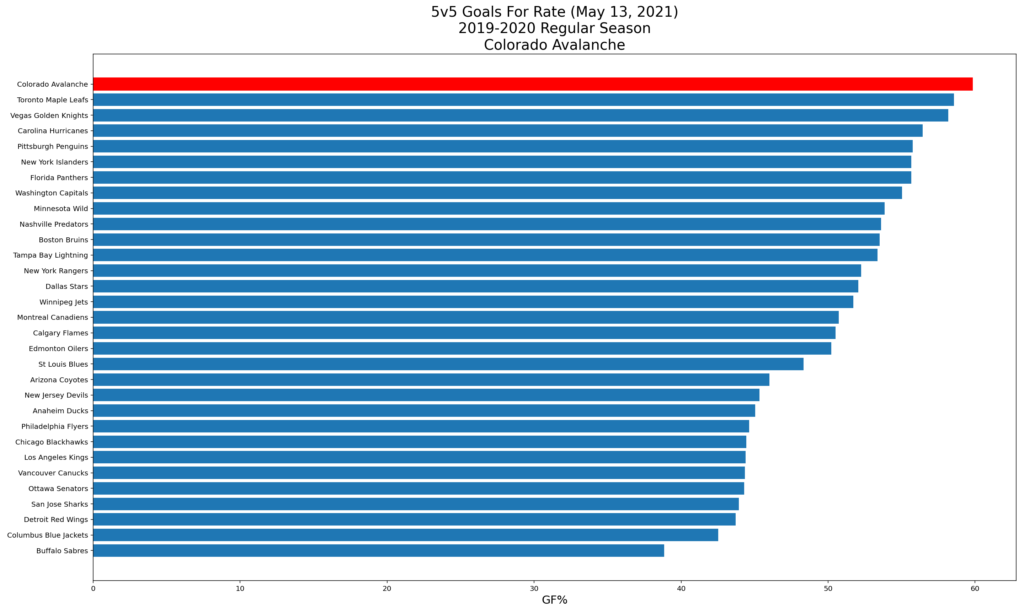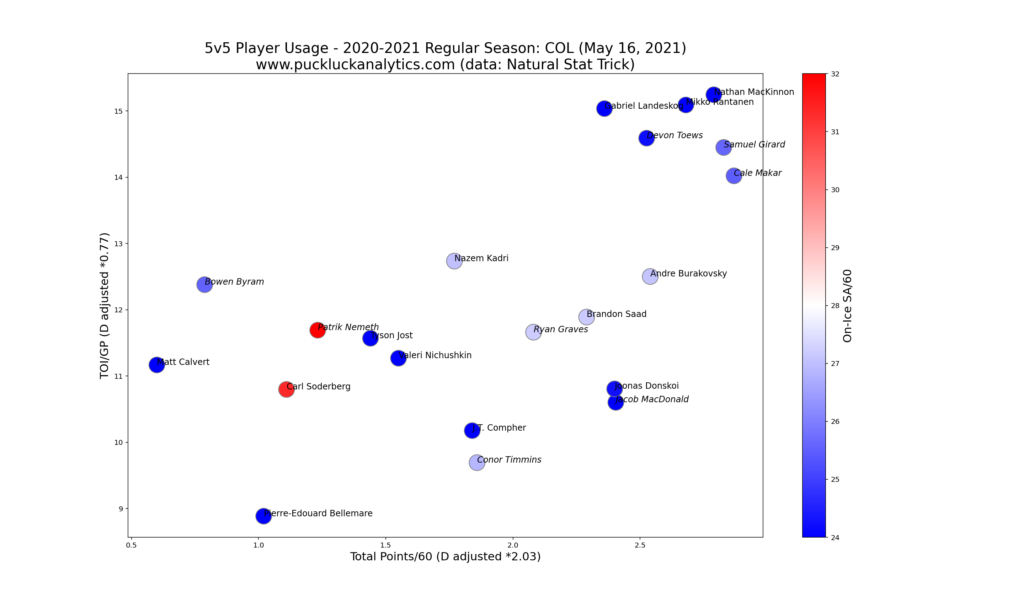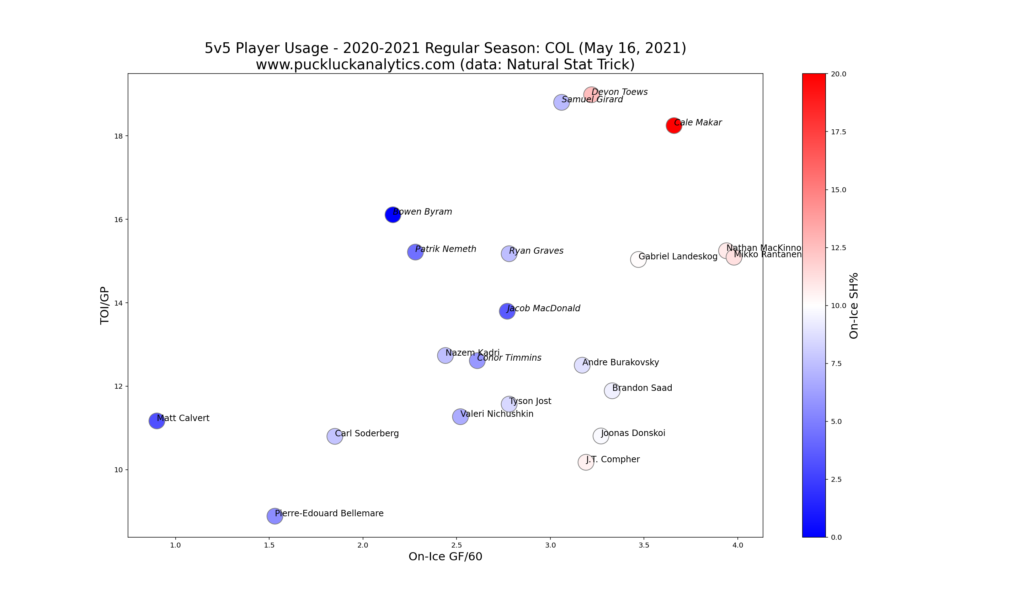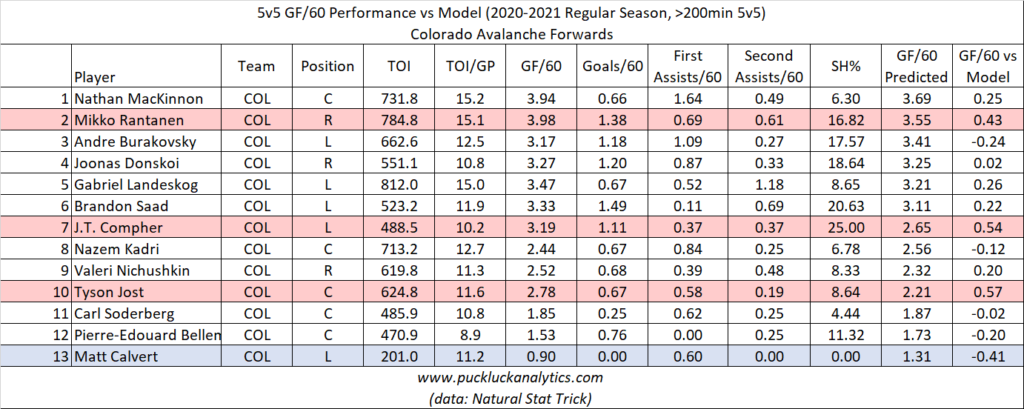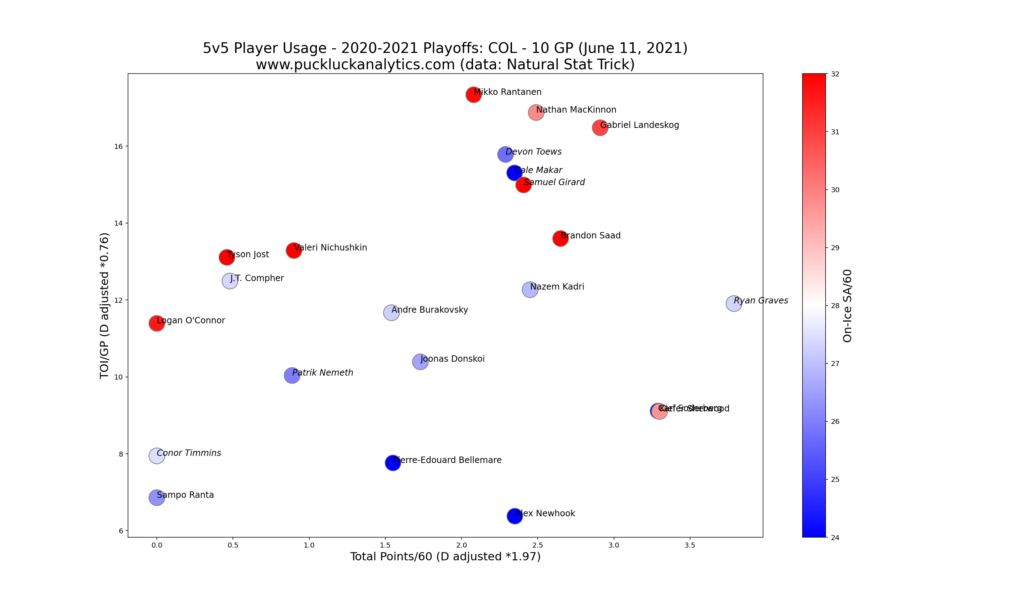The Colorado Avalanche sat in fourth place in the West Division at about the mid-way mark of the regular season. They turned on the gas in the second half and wrestled the top seed and President’s Trophy away from the Vegas Golden Knights in the final games of the season. After a disappointing second round exit at the hands of the same Golden Knights team, let’s take a look at the season that was in Denver. I recommend giving this post a read for more detail on some of the plots we’ll look at in our review.
Overall Performance (Regular Season)
The Avalanche finished tied for the best record in the NHL with the Vegas Golden Knights and won the President’s Trophy on the strength of tie-breakers. Let’s take a look at how our points predictor model, which uses only 5v5 inputs, ranks the Avs relative to the actual standings.
The Avs’ actual point percentage is very close to the model prediction, suggesting that their results were backed by strong 5v5 play. We see them pull ahead of the Golden Knights slightly in the model results, suggesting they were the (slightly) better team at 5v5.
Let’s take a look at the 5v5 goal rates that the model uses as input.
The Avalanche were an elite all-around team at 5v5 this season, with the best 5v5 GF/60 and the third best 5v5 GA/60 in the entire league. Together, this made them the top team for 5v5 goals for percentage in the league.
Player Performance (Regular Season)
We’ll start to dig into player performance by looking at a 5v5 usage chart, with defensemen’s stats factored for comparison with forwards. As a result, we get a visual depth chart with the top players located at the top right of the chart and the rest of the roster following a diagonal line toward the bottom left.
The Avs’ top line of Nathan MacKinnon, Gabriel Landeskog, and Mikko Rantanen, along with their big three of Cale Makar, Devon Toews, and Sam Girard on defense, clearly led the way this season. The rest of the players follow a roughly diagonal distribution, however it does look more like a hockey stick with the big guns at the top. From this chart, it appears that the Avs leaned heavily on their top players.
We’ll look at individual contributions to 5v5 GF/60 by plotting on-ice GF/60 vs TOI/GP. Players located further to the top right on this plot had larger contributions to team scoring rates.
Not surprisingly, we see the Avs’ stars leading the way again on this chart. We also see strong offensive impact from Joonas Donskoi, JT Compher, Brandon Saad, and Andrei Burakovsky that could possibly be optimized with some additional ice time, possibly taking some of the offensive load off the top line.
By plotting on-ice SA/60 vs TOI/GP, we get a similar visual for defensive contributions. This time, players located further left and down had stronger contributions to limiting team 5v5 GA/60.
We see most of the Avalanche skaters clustered around 24 SA/60. This is well under the league average of 30 and was clearly a factor in the Avalanche’s strong defensive results. Nazem Kadri, Burakovsky, and Saad are further left, however still with low overall shot rates against. Their higher numbers may simply be due to deployment against opposing top lines.
Next, we’ll use our on-ice GF/60 models to assess which players may have carried their line mates. We’ll use the variance between the model output and actual to do this, with variances greater than about 0.3 of interest. Negative variances suggest a player carried their line mates.
Rantanen, Compher, and Tyson Jost appear to have been carried offensively by their line mates at first glance. In Compher’s case, he has an incredibly high shooting percentage that is inflating the model so the variance probably should be even higher.
Cale Makar and Devon Toews are the only defensemen that stand out with variances over our threshold and both appear to have been carried by their line mates. This may be due to deployment, as both were utilized often with Colorado’s top line and we expect the Avs’ elite forwards to drive offense. In Makar’s case, he played roughly half of his 5v5 time with MacKinnon.
The Avalanche had quality starting goaltending from Philipp Grubauer this season. Their situation at the backup position was less sound. They tried a few options, but none provided them with even average goaltending when Grubauer was given a day off.
Playoff Performance
The Avalanche looked like the powerhouse they were in the regular season during round 1, sweeping the Blues and setting up a date between the top two regular season teams in round 2. The Vegas Golden Knights came out on top of the battle of the titans and the Avalanche’s strong season came to an early end. While their 10 playoffs games is too small a sample to make any long term projections, let’s take a look at a 5v5 usage chart to gain some insight on their playoff run.
The Avs’ playoff usage chart looks reasonably similar to their regular season chart, considering the small sample size. The biggest difference is that there isn’t the same gap between their stars and the rest of the roster. This is likely a sign that the Golden Knights were able to hold the Avs stars in check well enough to prevail in a hard fought series.
Looking Ahead
With nearly $62M already committed to the 2021-2022 cap and numerous pending free agents on their roster, the Avalanche have some work ahead this summer to maintain their elite roster.
Key RFAs:
The Avalanche have only a few pending RFAs to re-sign this offseason. The list is headlined by Cale Makar, who is sure to see a significant raise from his entry level deal.
Key UFAs:
The Avs have a number of pending UFAs that will leave roster positions to fill for next season. Captain Gabriel Landeskog is the biggest name on the list. He is likely to command a raise over his expiring cap hit of just over $5.5M on the open market so there is certainly a possibility that he becomes a cap casualty for the Avalanche. Brandon Saad was another important player this year and is also head for unrestricted free agency. Vezina candidate Philipp Grubauer heads to free agency as well.
Key Players Under Contract:
Nathan MacKinnon is under contract for two more seasons at a cap hit of only $6.3M. Now in his prime, if he continues to play himself into the Hart Trophy discussion he will provide excellent value for the Avs.
Tough Questions:
Can the Avalanche bring back the captain? With Landeskog headed to unrestricted free agency and likely due a raise, the Avs may have more pressing needs to fill with their available cap space. Cale Makar will get a raise and the Avs have no proven NHL goaltenders under contract for next season as they head into the offseason.
Offseason Priority:
The Avalanche need netminders. Grubauer had a good season, however his Vezina nomination may have been helped along by a strong Avs’ defense. Whether they re-sign Grubauer or find another option, their success in filling the starter’s net will go a long way to determining their success next season. They also need to find a capable backup that can hold the fort when called upon.
Check out my other season reviews that are already up, such as the Minnesota Wild and the Florida Panthers, and subscribe to catch the rest of my season reviews as they come out.
data: Natural Stat Trick
cap data: CapFriendly

